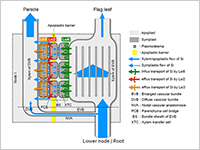Enlarge Image
Preferential distribution of silicon to rice grains
Silicon (Si) is the most abundant element in the Earth’s crust. Rice is able to accumulate high Si in the husk, where the element protects the grains from various stresses and enables the rice to maintain its production and high yield. However, the molecular mechanisms involved in the preferential delivery of Si to the husk are unknown.
Now, Naoki Yamaji, Jian Feng Ma and their colleagues at the Institute of Plant Science and Resources at Okayama University have found that this preferential distribution is mediated by the co-operation of three different Si transporters. These transporters are localized at different cell layers in the nodes of the rice plants.
Further collaboration with Gen Sakurai at the National Institute for Agro-Environmental Sciences uncovered that an apoplastic barrier, alongside the development of enlarged vascular bundles in the node, are also required for preferential Si distribution. Mathematical modelling of the processes allowed the team to pinpoint these specific details.
These findings provide a model case for studying the distribution mechanisms of other mineral elements. The team also hopes their findings will prove useful for the modification of rice crops by enhancing essential nutrients and reducing toxic elements in rice grains, for example.
Reference:
・Authors: Naoki Yamaji, Gen Sakurai, Namiki Mitani-Ueno, and Jian Feng Ma
・Title of original paper: Orchestration of three transporters and distinct vascular structures in node for inter-vascular transfer of silicon in rice
・Journal, volume, pages and year: Proceedings of the National Academy of Sciences of the United States of America 112, 11401-11406 (2015).
・Digital Object Identifier (DOI): 10.1073/pnas.1508987112
・Journal website: http://www.pnas.org/content/112/36/11401
・Affiliations: Institute of Plant Science and Resources, Okayama University Department website: http://www.rib.okayama-u.ac.jp/plant.stress/index.html
Reference(e-Bulletin) :
OKAYAMA UNIV. e-Bulletin. Plants feel stress! Vol.12, Sep, 2015.
http://www.okayama-u.ac.jp/user/kouhou/ebulletin/feature/vol12/feature_001.html

